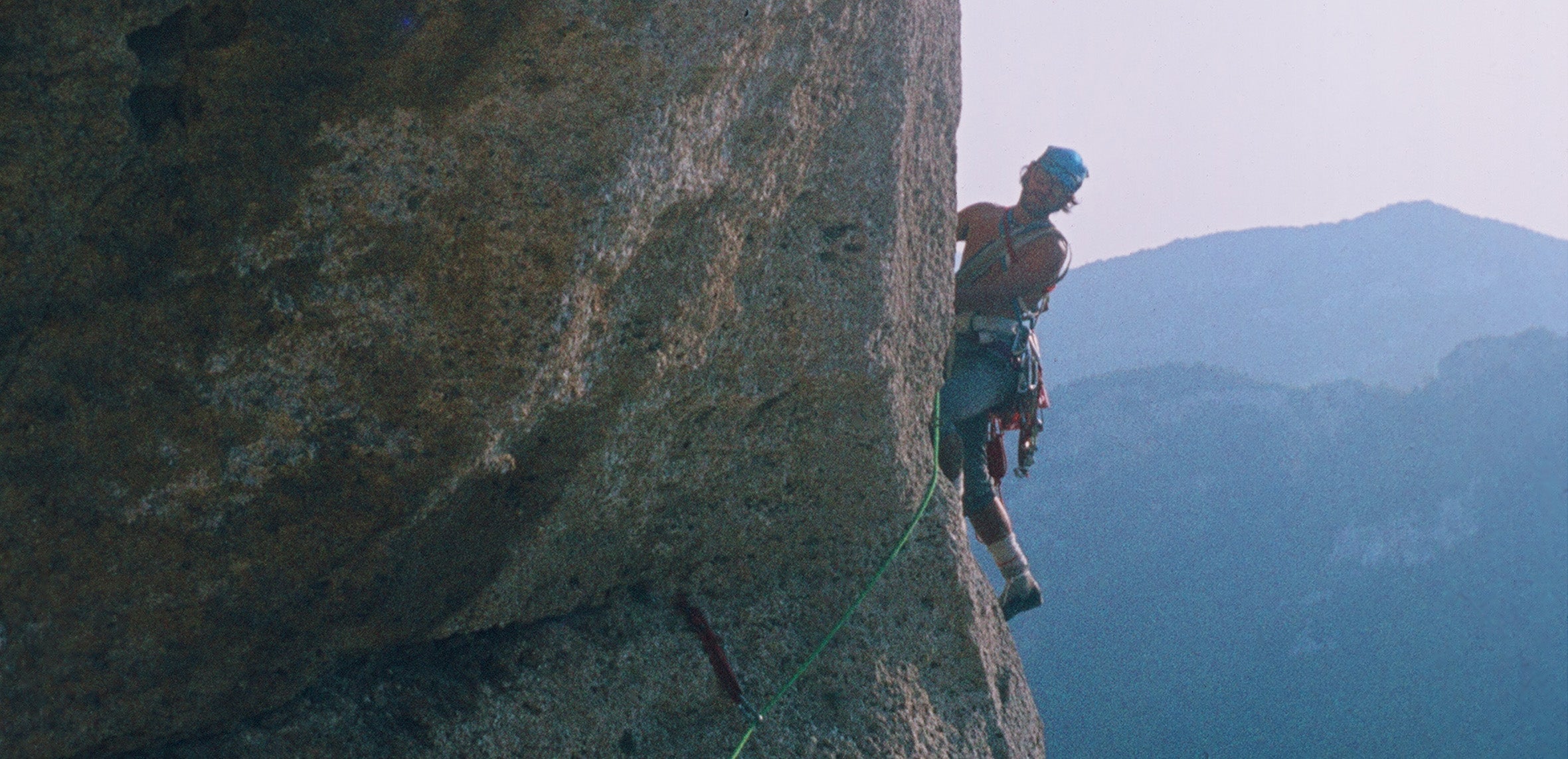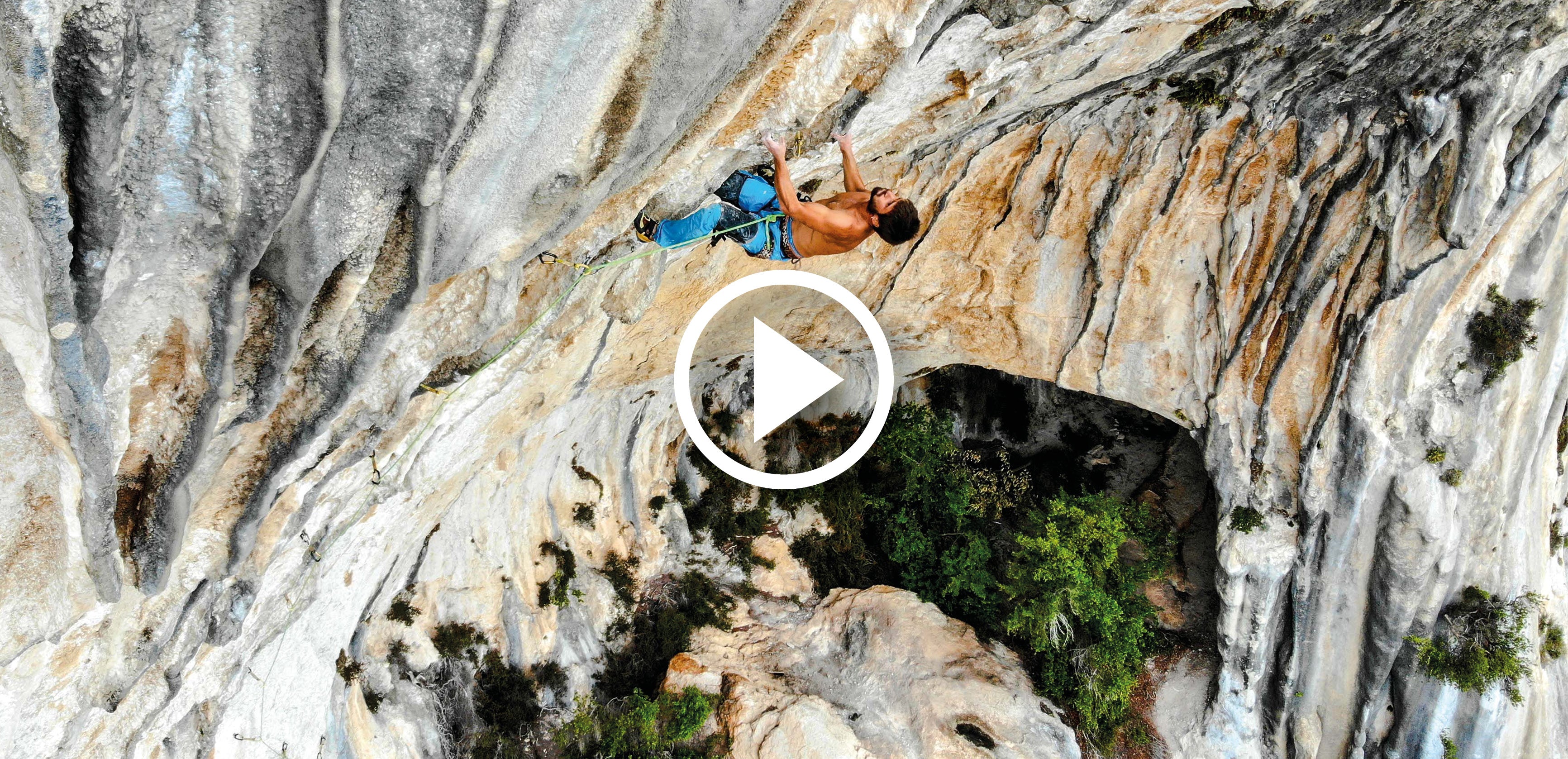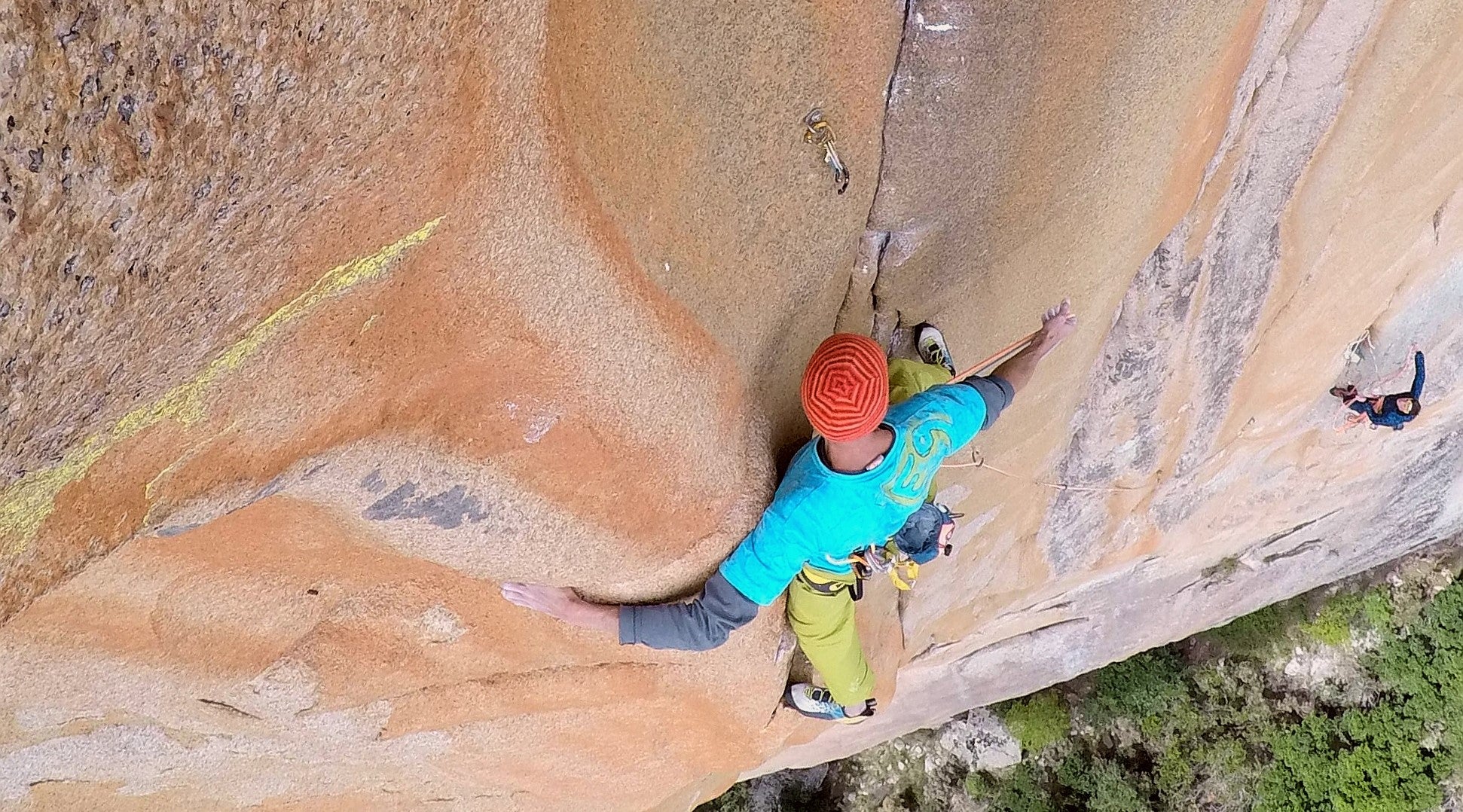
The dawn of sport climbing in Aosta Valley. Memories of a protagonist by Guido Azzalea
Published on 16/06/2020
It was the year 1970, I had attended a course of introduction to mountaineering with the Alpine Club of Aosta. The lessons were held at the gym of the Generale Cantore Castle in Aosta. In addition to meeting the instructors (all mountain guides), I went out for the first time from a world of mountain book readings and I would have known some friends to share the same passion.
People climbed with knee-length pants and boots. The only one who climbed with some kind of strange shoes with a rope sole was the guide Ourla who, besides being very good, had been a partisan leader and was generous with advice for all of us. After the course I often went to the Alpine Club headquarters in Aosta to meet new friends and also because there were several girls there. Not having a driving license yet, we moved by bicycle and often went to the Pollein crag. There were a few short lines on some bolted overhanging slab and to the left a line with a small horizontal roof that frightened me. Another place was the BC gym (now also covered with containment nets). I used a rope, carabiners and aiders with metal steps. You climbed in the gym not really for the sake of climbing but with the intent to prepare to go and do those things in the mountains. Later I met Pino Trevisan who one day asked me to go with him to Pollein to make some moves ... to the bottom left he showed me some passages 2/3 meters above the ground that seemed impossible to me.
Among other things, he climbed with Clark's shoes with para rubber soles. Twist ... I must have been 13 and it seemed scandalous to me, but how? And the boots? Then came my first real mountain route with Ezio Donzel: the “Ottoz” at the Aiguille Croux. It was a terrifying battle. I don't remember how long it took us but if it hadn't been for Ezio's skill, things would have ended badly. For me it was a hard lesson ... one of many.
After getting acquainted with Roberto Francesconi, Alberto Cheraz and Daniele Presa I started to attend the Spataro Bivouac. We started on a Vespa from Aosta and stayed up for a few days. We didn't do anything exceptional but we liked the environment and got a little experience. In the meantime, I always met Marco Giordano at the CAI of Aosta. Marco was in those days someone that went outside our schemes. He went around with the springs in his hands and he did tractions. I met him one day at La Ravoire and he was crossing unroped on the edge of the cliff. La Ravoire in those days was much larger and to the left (after the “Friday” route) it continued with a beautiful wall furrowed by cracks. Later all this was swallowed and demolished to make the wall of the tunnel. Marco before a serious accident in the Dolomites would have opened in Machaby the first real climbing route on the Corma, the route “Sara” together with Danilo Chatrian. The concept of "crag" did not exist then, the routes were made by inserting pitons, and the more of them you put in, the more you felt good. Also in that period, I remember an attempt at “Spigolo Bozzetti” with Daniele Presa where, halfway, finding no more pitons, I climbed 15 meters along the edge, crawling like a snake up to the belay, risking a fall of about twenty meters. The first light shoes came out on the market to replace the boots. They all had a rigid sole and only a few models (such as the blue Galibier Yosemite) had a slightly soft sole. Also in that period, I met Gian Carlo Grassi with whom I went to climb to Briançon and for the first time I saw that he used two carabiners with a knotted tape to pass the pitons ... Great discovery !!!
Slowly the knickerbockers gave way to normal long pants ... Marco Giordano even climbed in blue jeans ... the first low harnesses (the Don Whillans) arrived among the wrath of old instructors who declared their absolute danger. In 1975 I took my driving license and therefore we moved a little better. We went to Arnad to the Gruviera crag.
The second pitch of “Topo pazzo” remained however a severe climbing test, there were perhaps four pitons ... it was better the “Diedro Rosso” where at least you could go up with the aiders. Before becoming mountain guide I began to make some ascents on the Mont Blanc, with Pietro Giglio we climbed La Salluard to Pic Adolphe (in those days we went to the top and not like now that we stop halfway) and the Contamine to Pointe Lachenal. In those days these routes were full of pitons and you didn't go too thin, you pulled everything, the important thing was to go to the top.
In that year, I had climbed alone the South East ridge of the Grand Combin and when I arrived to the top (I do not know now how!) I asked a Swiss guide from where I could descend to return to Italy ... he wanted at all costs that I went down with him to Switzerland and I had to run away so I wouldn't get caught. After obtaining the license as a mountain guide and not having the desire to study anymore, I decided to join the army (it was mandatory for some time then) in the Alpine Corps by signing for three years of service. It was a bit like starting all over again but that's another story and I'll tell you another time.
We are at the end of the 70s. The routes on the Corma continue to increase. Giannico Rossi with a few pitons and from the bottom climbs a nice variant to the “Diedro di Fausto” (Maga Magò), Vittor Pisani climbs “Freevolezze”, with Giannico I climb “Erbetta per Bianchina” (guess what I planted at the base?), With Ugo Page we climb a higher variant of the Jaccod (Principe Azzurro) .In that period Corrado Framarin came along, a very strong climber from Quart who will later give a strong shock to the movement in the Aosta Valley. At Corma he opens two beautiful lines, “Pépé le Moko” and “Hot Potato” together with Massimo Arcaro. Meanwhile, a strong climber from Friuli is came around, always climbing unroped at Gruviera. Ernesto Lomasti before his accident climbs the top pillar of the Corma. In my opinion this route will determine one of the historical turning points for us local climbers. With Alberto Cheraz we made perhaps the first repetition of the route being very scared. Two of our friends had tried in the previous days and one of the two had fallen on the initial oblique crack fracturing a leg, I remember that on our feet we had the famous yellow and black San Marco shoes. Shortly after, Corrado F. with Massimo A. climbed a line to the left of the line of Ernesto. Corrado showed all his skill by climbing a 30m flared dihedral, using only two pitons on a pitch that is now rated 6b+.
But let's go back to La Ravoire. One day Pascal Gravante shows up, a Swiss from Geneva but raised in Rome. He looked at the route “Fammi di tutto” and says: why don't you free climb it? We put the rope from above and tried it over and over. In a short time, other local climbers began to see and bolt new lines thanks to the bolts (always of 8 and put by hand). Hans Marguerettaz and Luca Ferraris among the most active. The fact is that in a short time we went from 6c to 7b. After a while there was also a certain Andrea Plat who, although very young, climbed well. “Monster Alfonso”, “Mexico and Clouds”, “Spit Fire”, “Rain and Tears” were born... The “Becco” in Courmayeur in my opinion had a great importance for climbing in the Valley. Angelo Piccioni had already put his hand on a part of the rocky portion to the left of the Becco couloir, bolting 2 itineraries of about 100 meters with difficulty around the fourth / fifth degree. Afterwards always from below with normal pitons and some bolts he climbed the two edges of the Becco, the “Mara 3” and the right edge. He opened another route in the center, a very beautiful route on a beautiful rock, but strangely little traveled. I don't remember who started bolting the central low sector. Massimo Datrino bolted two pitches all the way to the right, one is called “Captain Handcuff” of difficulty around 6b. After a while I bolted left the two pitches of “Mamma EB”. The second pitch is really beautiful characterized by a vertical granite with lists and the grade is around 6c. We must also remember we planted that the 8 mm bolts with the hand drill and therefore every single one of them required a few days of patient work. Valerio Bologna bolted a beautiful 2-pitch line and called it “Belfagor”. It must also be said that one day he decided to climb it unroped and in my opinion it was a real exploit ... we were in the early 80s. Another frequent visitor to the place was Hans Marguerettaz who bolted another 2-pitch line that he called “Bicycle Girl”. One of the first 7b pitches in the valley was born. Then I bolted another line to the right of the Hans one, that Manolo climbed on sight, grading it 7a + (I don't remember the name). The visitors of the site were always the same in those years, Carlo Ziggiotto, Bibo Colnaghi, Pierino Rey, Corrado Framarin and other locals. In 2000 with Pierino Rey I re-bolted all the lines with stainless steel bolts but unfortunately a few years later a large landslide affected the corner portion of the “Mara 3”, cancelling the first 3 pitches. A municipal ordinance prohibits access to the cliff and the path that led up to the access couloir has been completely cancelled. I went up for a tour a few years ago and found that the landslide event did not affect any of the lines, but unfortunately without adequate remediation the site remains at risk for me.
The “Becco” in Courmayeur in my opinion had a great importance for climbing in the Valley. Angelo Piccioni had already put his hand on a part of the rocky portion to the left of the Becco couloir, bolting 2 itineraries of about 100 meters with difficulty around the fourth / fifth degree. Afterwards always from below with normal pitons and some bolts he climbed the two edges of the Becco, the “Mara 3” and the right edge. He opened another route in the center, a very beautiful route on a beautiful rock, but strangely little traveled. I don't remember who started bolting the central low sector. Massimo Datrino bolted two pitches all the way to the right, one is called “Captain Handcuff” of difficulty around 6b. After a while I bolted left the two pitches of “Mamma EB”. The second pitch is really beautiful characterized by a vertical granite with lists and the grade is around 6c. We must also remember we planted that the 8 mm bolts with the hand drill and therefore every single one of them required a few days of patient work. Valerio Bologna bolted a beautiful 2-pitch line and called it “Belfagor”. It must also be said that one day he decided to climb it unroped and in my opinion it was a real exploit ... we were in the early 80s. Another frequent visitor to the place was Hans Marguerettaz who bolted another 2-pitch line that he called “Bicycle Girl”. One of the first 7b pitches in the valley was born. Then I bolted another line to the right of the Hans one, that Manolo climbed on sight, grading it 7a + (I don't remember the name). The visitors of the site were always the same in those years, Carlo Ziggiotto, Bibo Colnaghi, Pierino Rey, Corrado Framarin and other locals. In 2000 with Pierino Rey I re-bolted all the lines with stainless steel bolts but unfortunately a few years later a large landslide affected the corner portion of the “Mara 3”, cancelling the first 3 pitches. A municipal ordinance prohibits access to the cliff and the path that led up to the access couloir has been completely cancelled. I went up for a tour a few years ago and found that the landslide event did not affect any of the lines, but unfortunately without adequate remediation the site remains at risk for me.

Guido Azzalea
63 years old, Mountain Guide and Instructor, he loves above all sport climbing whose birth and evolution he has followed. Always a friend of Grivel, his favorite product is the TREND harness PYTHON.


